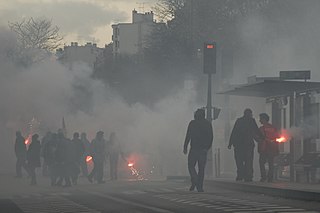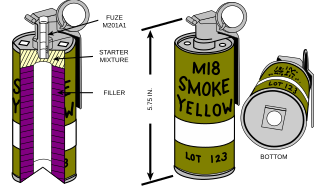
Magenta is a color that is variously defined as purplish-red, reddish-purple or mauvish-crimson. On color wheels of the RGB (additive) and CMY (subtractive) color models, it is located exactly midway between red and blue. It is one of the four colors of ink used in color printing by an inkjet printer, along with yellow, black, and cyan, to make all other colors. The tone of magenta used in printing is called "printer's magenta". It is also a shade of purple.

Potassium chlorate is a compound containing potassium, chlorine and oxygen, with the molecular formula KClO3. In its pure form, it is a white crystalline substance. After sodium chlorate, it is the second most common chlorate in industrial use. It is a strong oxidizing agent and its most important application is in safety matches. In other applications it is mostly obsolete and has been replaced by safer alternatives in recent decades. It has been used

A smoke grenade is a canister-type grenade used as a signaling device, target or landing zone marking device, or as a screening device for unit movements.

A smoke bomb is a firework designed to produce smoke upon ignition. Smoke bombs are useful to airsoft games, paintball games, self-defence and practical jokes. They are also used in smoke tests.

A smoke screen is smoke released to mask the movement or location of military units such as infantry, tanks, aircraft, or ships.

Thermochromism is the property of substances to change color due to a change in temperature. A mood ring is an excellent example of this phenomenon, but thermochromism also has more practical uses, such as baby bottles which change to a different color when cool enough to drink, or kettles which change when water is at or near boiling point. Thermochromism is one of several types of chromism.
Vat dyes are a class of dyes that are classified as such because of the method by which they are applied. Vat dyeing is a process that refers to dyeing that takes place in a bucket or vat. The original vat dye is indigo, once obtained only from plants but now often produced synthetically.
The military of the United States has used many different types of hand grenades since its foundation. Presented on this page is a basic overview.

Disperse Red 9, or 1-(methylamino)anthraquinone, is a red dye derived from anthraquinone. Disperse Red 9 is used in some older red and violet-red colored smoke formulations. It is used in the M18 colored smoke grenade and also often in dye packs. Its smoke producing properties can be improved by coating the dye particles with an inert material, e.g. an epoxy resin.

Fuel dyes are dyes added to fuels, as in some countries it is required by law to dye a low-tax fuel to deter its use in applications intended for higher-taxed ones. Untaxed fuels are referred to as "dyed", while taxed ones are called "clear" or "white".

Colored fire is a common pyrotechnic effect used in stage productions, fireworks and by fire performers the world over. Generally, the color of a flame may be red, orange, blue, yellow, or white, and is dominated by blackbody radiation from soot and steam. When additional chemicals are added to the fuel burning, their atomic emission spectra can affect the frequencies of visible light radiation emitted - in other words, the flame appears in a different color dependent upon the chemical additives. Flame coloring is also a good way to demonstrate how fire changes when subjected to heat and how they also change the matter around them.

Benzanthrone (BZA) is a polycyclic aromatic hydrocarbon. It is a yellow solid. Its derivatives are used as a dyestuff intermediate for anthraquinone-based dyes. Dehydrogenative coupling gives violanthrone. It is prepared by reduction of anthroquinone to anthrone followed by alkylation with a mixture of glycerol and sulfuric acid.

Solvent Violet 13, also known as D&C Violet No.2, oil violet, Solvent Blue 90, Alizarine Violet 3B, Alizurol Purple, Duranol Brilliant Violet TG, Ahcoquinone Blue IR base, Quinizarin Blue, Disperse Blue 72, and C.I. 60725, is a synthetic anthraquinone dye with bright bluish violet hue. It is a solid insoluble in water and soluble in acetone, toluene, and benzene. Its chemical formula is C21H15NO3, and its structure is 1-hydroxy-4-(p-tolylamino)anthraquinone, or 1-hydroxy-4-[(4-methylphenyl)amino]-9,10-anthracenedione or 1-hydroxy-4-(4-methylanilino)anthraquinone.

Victoria blue BO, also known as C.I. Basic Blue 7 and C.I. 42595, is a chloride salt of a dye with the chemical formula [C33H40N3]Cl. It has the appearance of a reddish blue powder. Victoria Blue BO base, also known as Solvent Blue 5 and C.I. 42595:1, is the hydroxide derivative of the same cation. Its chemical formula is [C33H4oN3]OH. Victoria blues are members of the triarylmethane dyes, but unlike most such dyes, the Victoria blues have an naphthylamine group.
A pyrotechnic composition is a substance or mixture of substances designed to produce an effect by heat, light, sound, gas/smoke or a combination of these, as a result of non-detonative self-sustaining exothermic chemical reactions. Pyrotechnic substances do not rely on oxygen from external sources to sustain the reaction.

The M18 Colored Smoke Grenade is a US Army grenade used as a ground-to-ground or ground-to-air signaling device, a target or landing zone marking device, or a screening device for unit maneuvering.
A smoke composition is a pyrotechnic composition designed primarily to generate smoke. Smoke compositions are used as obscurants or for generation of signaling smokes. Some are used as a payload of smoke bombs and smoke grenades.

Glass coloring and color marking may be obtained in several ways.
- by the addition of coloring ions,
- by precipitation of nanometer sized colloides,
Methine dyes are dyes whose chromophoric system consists of conjugated double bonds (polyenes) flanked by two end groups: an electron acceptor A and an electron donor D.
Structural of methine dyes















